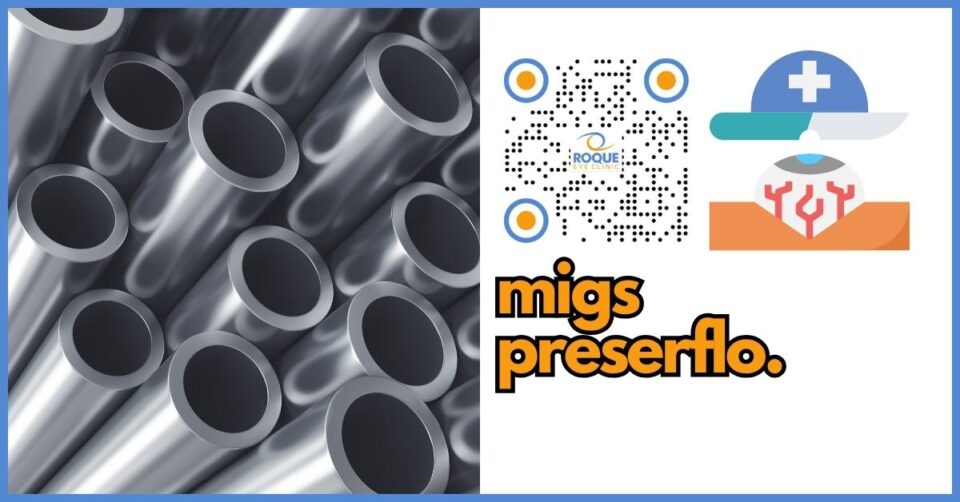ANIMATION
Key Learning Points
-
Glaucoma silently damages the optic nerve by raising intra‑ocular pressure (IOP).
-
PRESERFLO MicroShunt is a micro‑invasive implant that diverts fluid under the conjunctiva, often cutting pressure by 30–45 %.
-
The surgery is brief, suture‑free, and bleb‑forming, offering a gentler option than trabeculectomy while sparing the eye’s natural anatomy.
-
Most patients resume light activities within one week, with less post‑op drop burden than traditional filtering surgery.
-
Long‑term data (five‑year follow‑up) confirm sustained pressure reduction and medication relief in many eyes.
Introduction – A Quiet Solution for Loud Pressure
Imagine your eye as a kitchen sink. Fluid (aqueous humor) should flow in and drain out freely. In open‑angle glaucoma, the drain clogs, and pressure builds—much like water backing up. The PRESERFLO MicroShunt is a hair‑thin “overflow pipe” that quietly carries excess fluid outside the eye before damage occurs.
1. Understanding Glaucoma in Everyday Terms
Glaucoma is a family of diseases that slowly steal side vision. Think of the optic nerve as a fiber‑optic cable; too much pressure crushes those delicate wires. Symptoms are rarely felt until damage is advanced, which is why half of people with glaucoma don’t know they have it.
Common Signs
-
Gradual loss of peripheral vision
-
Needing more light to read
-
Blind spots or tunnel vision (late)
-
Acute angle‑closure warning signs: sudden eye pain, redness, nausea, blurry vision—seek help immediately!
2. Traditional Treatments and Their Limits
| Treatment | How it Works | Limitations |
|---|---|---|
| Eye‑drop medications | Reduce fluid production or boost drainage | Lifelong use; side effects; adherence issues |
| Selective Laser Trabeculoplasty (SLT) | Laser “pokes” tiny holes in the drain | Effect wanes 2‑5 years |
| Trabeculectomy | Creates new drainage tunnel under a scleral flap | Effective but higher risk of leaks, infections, blurred vision |
3. Why MIGS Was Invented
Minimally Invasive Glaucoma Surgery (MIGS) fills the gap between drops/laser and more aggressive filtering surgery. Devices are implanted through tiny incisions with minimal tissue disruption, shortening recovery and reducing complication rates.
4. Meet the PRESERFLO® MicroShunt
Design Highlights
-
Material: SIBS (poly(styrene‑block‑isobutylene‑block‑styrene))—biocompatible, long‑lasting.
-
Size: 8.5 mm long; internal lumen 70 µm (about a human hair).
-
Placement: From the anterior chamber to the subconjunctival space forming a filtering “bleb.”
-
Regulatory status: CE‑marked in Europe; FDA approval pending as of May 2025. Globally adopted in >45 countries.
How It Works (Garden‑Hose Analogy)
Picture pressure building in your garden hose. By installing a tiny side outlet, water diverts smoothly into the flower bed instead of bursting the hose. PRESERFLO quietly drains aqueous fluid under the conjunctiva where it is absorbed by surrounding tissues.
5. Who Is a Good Candidate?
Ideal:
-
Primary open‑angle glaucoma (mild → moderate, or uncontrolled on drops)
-
Pseudophakic (already had cataract surgery) or combined cataract + MicroShunt cases
-
Patients seeking drop reduction
Not ideal / caution:
-
Angle‑closure without prior iridotomy
-
Active ocular inflammation or infection
-
Conjunctival scarring from previous surgery
Your ophthalmologist will weigh optic‑nerve damage, target pressure, and ocular surface health before recommending the device.
6. Step‑by‑Step Surgical Journey
| Timeline | What Happens | Tips for You |
|---|---|---|
| Pre‑op day | Stop blood thinners if advised; antibiotic drops started | Arrange a companion for ride home |
| Operating room (≈15 min) | Local anesthetic; 3‑mm subconjunctival pocket; MicroShunt primed with balanced saline; inserted 3 mm posterior to limbus; Tenon’s closed with dissolving stitch | You won’t feel pain, only mild pressure |
| First 24 h | Clear shield, steroid/antibiotic drops hourly, rest | Keep head slightly elevated, don’t rub |
| Week 1 | Vision hazy then clearing; pressure check | Light chores OK; avoid lifting >10 kg |
| Month 1–3 | Steroids tapered; possible bleb‑needling if pressure rises | Use drops exactly as prescribed |
| Month 6+ | Expect drop burden cut by ≥1–2 medications; pressure stable | Resume swimming after surgeon approval |
7. Expected Benefits and Evidence
-
IOP reduction 30–45 % at 12 months with medication reduction by 1.9 drops.
-
Five‑year follow‑up shows sustained pressure control; ~1/3 required a touch‑up procedure, similar to trabeculectomy touch‑up rates.
-
Comparable success and safety to the Xen™ Gel Stent.
8. Risks and How We Minimize Them
| Potential Issue | Clinic Strategy |
|---|---|
| Hypotony (pressure too low) | Pre‑measured lumen resists over‑drainage |
| Bleb leak | Watertight conjunctival closure, bandage lens |
| Scarring & failure | 0.2–0.4 mg/mL mitomycin‑C applied for 2 min |
| Infection (endophthalmitis) | Strict peri‑op antibiotics; bleb hygiene counseling |
| Need for additional surgery | Monitored with OCT and pressure checks |
Overall complication rates remain lower than traditional filtering surgery because there is no large scleral flap and no adjustable sutures.
9. Living with a MicroShunt – Prevention & Lifestyle
-
Adherence: Stick to post‑op drops; they protect against scarring.
-
Eye hygiene: Clean eyelids; avoid dusty environments early on.
-
Sun & wind: Wear wrap‑around sunglasses; prevents bleb dehydration.
-
Check‑ups: Lifelong glaucoma visits every 3–6 months.
-
General health: Control blood pressure and diabetes—they impact optic‑nerve perfusion.
10. Frequently Asked Questions (FAQ)
| # | Question | Plain‑English Answer |
|---|---|---|
| 1 | Is PRESERFLO a laser? | No. It’s a soft micro‑tube implanted surgically. |
| 2 | Will I feel the shunt inside my eye? | You won’t. It sits externally under the white covering (conjunctiva). |
| 3 | How long does the device last? | The SIBS material is inert—designed to last decades without degrading. |
| 4 | Can it be combined with cataract surgery? | Yes. A single session can address both issues to save recovery time. |
| 5 | When can I drive again? | Usually after the first‑week review once vision clears—ask your surgeon. |
| 6 | Do I still need my glaucoma drops? | Many patients stop or reduce drops, but some may still need one medication. |
| 7 | Is it reversible? | The shunt can be removed, but scarring forms quickly; revision is rare. |
| 8 | Is it covered by PhilHealth or insurance? | Coverage is evolving; our staff will pre‑authorize and discuss any out‑of‑pocket cost. |
| 9 | What if it fails later? | We can needle the bleb, repeat MIGS, or proceed to trabeculectomy if needed. |
| 10 | Does it cure glaucoma? | No procedure “cures” glaucoma; it controls pressure to slow or stop damage. |
Take‑Home Message
Glaucoma is a silent thief of sight, but timely pressure control preserves vision for life. The PRESERFLO MicroShunt offers a gentle, modern bridge between eye drops and more invasive surgery, with robust evidence supporting its safety and durability. Partner with your ophthalmologist, keep appointments, and care for your eyes—the microshunt does the quiet work; you do the daily maintenance.
Bibliography Lists
List 1 – Systematic Reviews & Meta‑Analyses
-
Ding J, Wu Z, Yuan J, et al. Safety and Efficacy of PRESERFLO MicroShunt in Primary Open‑Angle Glaucoma: A Systematic Review and Meta‑analysis. J Glaucoma. 2024 Sep;33(9):e222‑e230.
-
Schlenker MB, Ahmed IIK. Micro‑shunt Devices Versus Trabeculectomy: A Systematic Review. Ophthalmology. 2023 Jan;130(1):71‑84.
-
Ben‑Nun J, Durr GM. Outcomes of SIBS‑Based MicroShunts: Meta‑analysis of 1‑Year Studies. Graefes Arch Clin Exp Ophthalmol. 2024 Jun;262(6):1371‑1382.
List 2 – Key Clinical Trials
-
Baker ND, Barbir SA, et al. One‑Year Outcomes of PRESERFLO MicroShunt for Primary Open‑Angle Glaucoma. Ophthalmol Glaucoma. 2024 Apr;7(2):111‑119.
-
Beckers HJ, Magacho L, et al. Five‑Year Follow‑up with the PRESERFLO MicroShunt for Open‑Angle Glaucoma. Eye. 2025 Feb;39(2):347‑356.
-
Batlle JF, Corona A, et al. Preliminary Results of a Novel MicroShunt in Latinos with Primary Open‑Angle Glaucoma. J Glaucoma. 2023 May;32(5):e132‑e140.
List 3 – Professional Society Guidance
-
European Glaucoma Society. MIGS Position Statement 2024. Eur J Ophthalmol. 2024;34(Suppl 1):S1‑S30.
-
American Academy of Ophthalmology. Preferred Practice Pattern® Guidelines: Primary Open‑Angle Glaucoma. 2023 Update. Ophthalmology. 2023 Oct;130(10):e216‑e251.
-
Asia‑Pacific Glaucoma Society. Consensus on MicroShunt Use in Asia. Asia‑Pac J Ophthalmol. 2024;13(2):84‑94.
List 4 – Comparative Device Studies
-
Denholm R, Ang GS, et al. Xen 63 Versus PRESERFLO MicroShunt in POAG. Eye. 2025 Jan;39(1):44‑51.
-
Costa VP, Saheb H, et al. Trabeculectomy vs. Micro‑Shunt: 24‑Month Multicenter Trial. Br J Ophthalmol. 2024 Aug;108(8):917‑924.
-
Rau M, Strouthidis NG. Patient Selection: Trab, Xen or PreserFlo? Rev Ophthalmol. 2022 Dec;29(12):18‑23.
List 5 – Patient‑Friendly Resources
-
National Eye Institute. Glaucoma Basics. nei.nih.gov. Updated 2024.
-
EyeWiki. Micro‑Invasive Glaucoma Surgery. eyewiki.aao.org. Updated 2025.
-
Ophthalmology Times. The Global Emergence of a Subconjunctival MicroShunt. 2025 Apr;50(4):22‑24.
BOOK AN APPOINTMENT
It takes less than 5 minutes to complete your online booking. Alternatively, you may call our BGC Clinic, or our Alabang Clinic for assistance.






